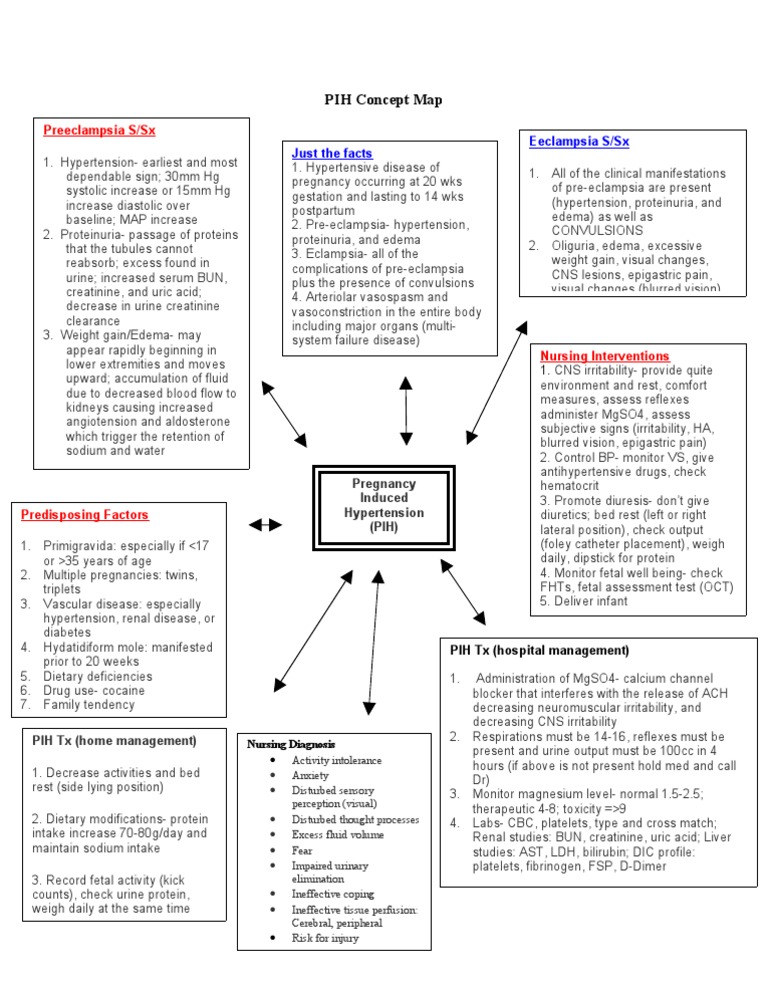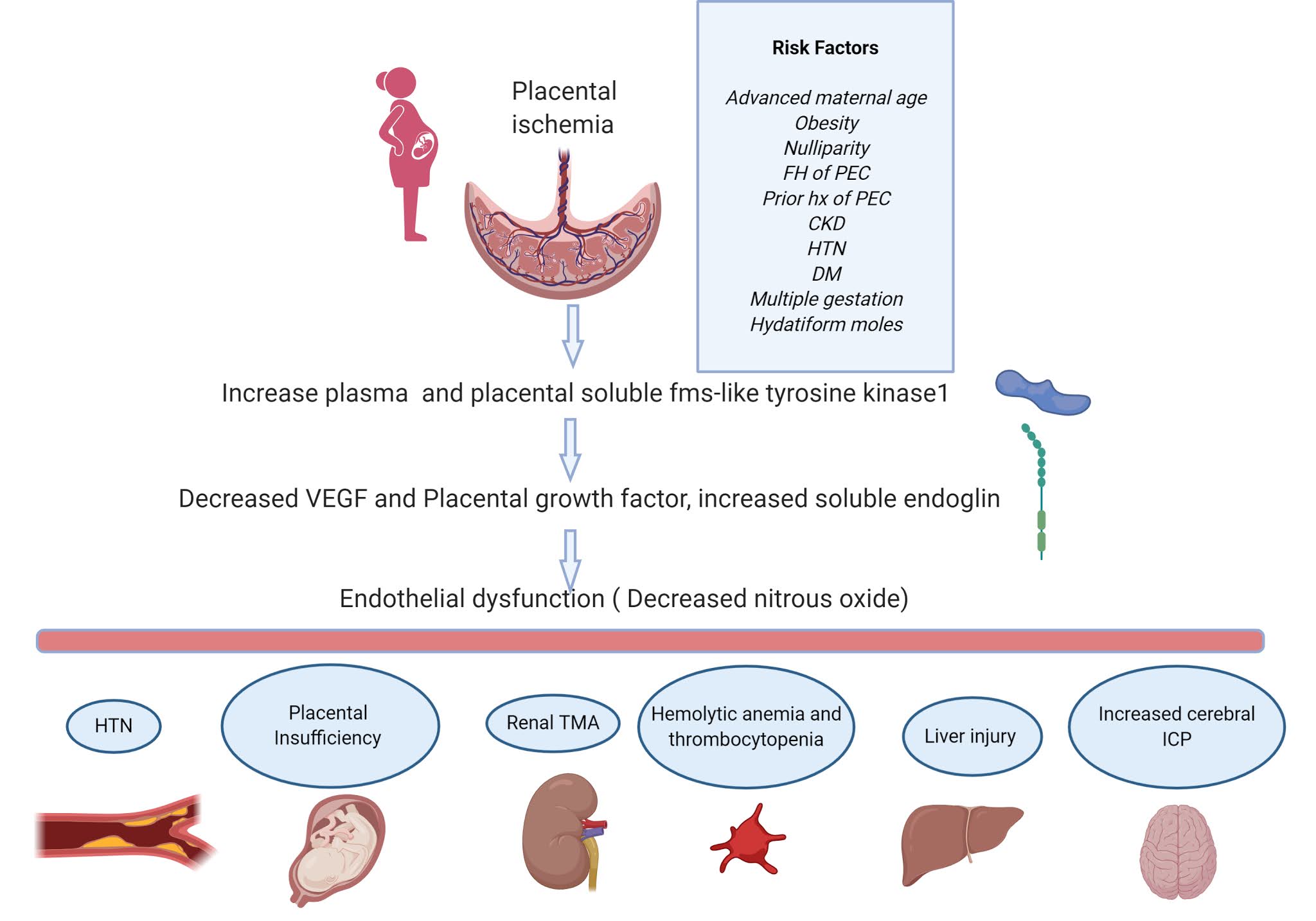
Pin on Nursing Stuff
Pre-eclampsia is gestational hypertension (blood pressure greater than 140 and/or 90) by the evidence of proteinuria or organ dysfunction. Upon assessment, I would expect to find proteinuria, elevated BP, edema, or weight gain and if severe, nausea vomiting, changes in vision, and abdominal What are you on alert for? Only treatment is delivery.

(PDF) Endothelial Dysfunction as a Consequence of Endothelial
Preeclampsia Concept Map - Pathophysiology/Etiology: Assessment: Possible Complications: Labs/Tests: - Studocu *Defective spiral artery remodeling *Systemic vasoconstriction & endothelial *Family that had Preeclampsia *Younger than 18, older than 35 *Medical conditions (Chronic HTN, renal disease, diabetes, autoimmune disease)

Preeclampsia Care Map PDF Medical Specialties Clinical Medicine
Pre-eclampsia is a medical condition that arises from persistent high blood pressure at around 20 weeks of pregnancy, causing damage to organs such as kidneys and liver. Kidney damage is characterized by the presence of protein in the urine, known as proteinuria.

Concept map Preeclampsia Tiffany Campbell Nursing Interventions
Preeclampsia is a hypertensive disorder in pregnancy related to 2% to 8% of pregnancy-related complications worldwide. It results in 9% to 26% of maternal deaths in low-income countries and 16% in high-income countries. Preeclampsia is defined as new-onset hypertension. The parameters for initial identification of preeclampsia are specifically defined as a systolic blood pressure of 140 mm Hg.

PIHconceptmap Hypertension Health Sciences
Concept Map Otitis Media Med Math Comprehensive Review (Answer Key) Some documents on Studocu are Premium. Upgrade to Premium to unlock it. Students shared 241 documents in this course emp, HR, & BP) "Blood pressure may fluctuate and spike quick ly; monitor for changes and elevations" (Nursing.com, n.d.). 2. Maintain strict I&O and document Q

Preeclampsia and Related Cardiovascular Risk Common Background
1. Managing Hypertension and Maintaining Effective Cardiac Output 2. Preventing Fluid Retention 3. Maintaining Adequate Tissue Perfusion 4. Preventing Injury 5. Promoting Adequate Nutrition 6. Initiating Patient Education and Health Teachings 7. Administer Medications and Provide Pharmacologic Support Evaluation Recommended Resources See also

Nephron Power Concept Map Pre eclampsia (PEC)
a Concept Map Approach Risk Factors for preeclampsia Maternal and Fetal Risks Chronic HTN, Gestational HTN, or Pre-eclampsia? use your post-its to incorporate concepts Signs and symptoms of preeclampsia Medical Management and Nursing Care Show full text
[Solved] Produce a concept map for preeclampsia with 6 main diagnosis
Concept Map preeclampsia.docx Galen College of Nursing NURSING nur265 Preeclampsia Concept Map.docx No School AA 1 Concept Map Preeclampsia.docx City Colleges of Chicago, Harry S Truman College NURSING 211 homework Renal Physiology.docx Solutions Available Mansfield High School, Mansfield SCIENCE 103

Preeclampsia concept map Ob Nursing Student, Lvn Student, Nursing
Introduction. The criteria that define pre-eclampsia have not changed over the past decade. 1, 2 These are: onset at >20 weeks' gestational age of 24-hour proteinuria ≥30 mg/day or, if not available, a protein concentration ≥30 mg (≥1+ on dipstick) in a minimum of two random urine samples collected at least 4-6 hours but no more than 7 days apart, a systolic blood pressure >140 mmHg.

Simulation Concept Map PreEclampsia Simulation Concept Map Describe
Severe Preeclampsia: Blood Pressure of 160/110 r higher (on two occasions, 6 hours apart), proteinuria of 5g or higher, dipstick urine protein measurement of 3+ to 4+ (two random samples, 4 hours apart), Oliguria (equal to or less then 500mL in 24 hours), Visual cerebral disturbances (frontal headaches, blurred vision, scotomata), cyanosis or pu.

VEAL CHOP Nursing Explained 10+ Mnemonics for Maternal & Child
Pre-eclampsia is a common disorder that particularly affects first pregnancies. The clinical presentation is highly variable but hypertension and proteinuria are usually seen. These systemic signs arise from soluble factors released from the placenta as a result of a response to stress of syncytiotrophoblast.

Pin on Nursing Concept Maps
Nursing Concept Map For Preeclampsia Book Review: Unveiling the Power of Words In a global driven by information and connectivity, the energy of words has be more evident than ever. They have the capability to inspire, provoke, and ignite change. Such may be the essence of the book Nursing Concept Map For Preeclampsia, a literary

Concept map preeclampsia Nursing Dx Risk for seizures related to
Interventions: 1. Administer antihypertensives as prescribed and check BP every q2h 2. Administer Magnesium Sulfate as prescribed. Pad bed rails, place bed in lowest position, and have necessary equipment at the bedside. 3. Measure strict I&O to monitor kidneys. 4. Monitor FHR q2h. 5.

SOLUTION Preeclampsia concept map Studypool
Concept Map preeclampsia.docx - Assessment Data Things to watch for Disease: Pre-Eclampsia Assess for blood pressure 140/90. Assess urine for | Course Hero Concept Map preeclampsia.docx - Assessment Data Things to. Doc Preview Expected Medications: Drug of choice for severe pre-eclampsia is Magnesium Sulfate to prevent seizures.

Preeclampsia System Disorder Template
Preeclampsia is a pregnancy complication portrayed by high blood pressure and signs of damage to another organ system, mostly the kidneys and the liver. Preeclampsia usually arises after 20 weeks of pregnancy in women who previously had normal blood pressure. Diagnosis

Preeclampsia > eclampsia Nursing & Nursing school Pinterest Watches
preeclampsia, which can be isolated or superposed on chronic hypertension. In this group, arterial hypertension is defined as systolic blood pressure equal to or greater than 140 mmHg and/or diastolic blood pressure equal to or greater than 90 mmHg, which should be measured on two distant occasions at least 4-6 hours apart, in a calibrated and adequate blood pressure monitor for the biotype of.